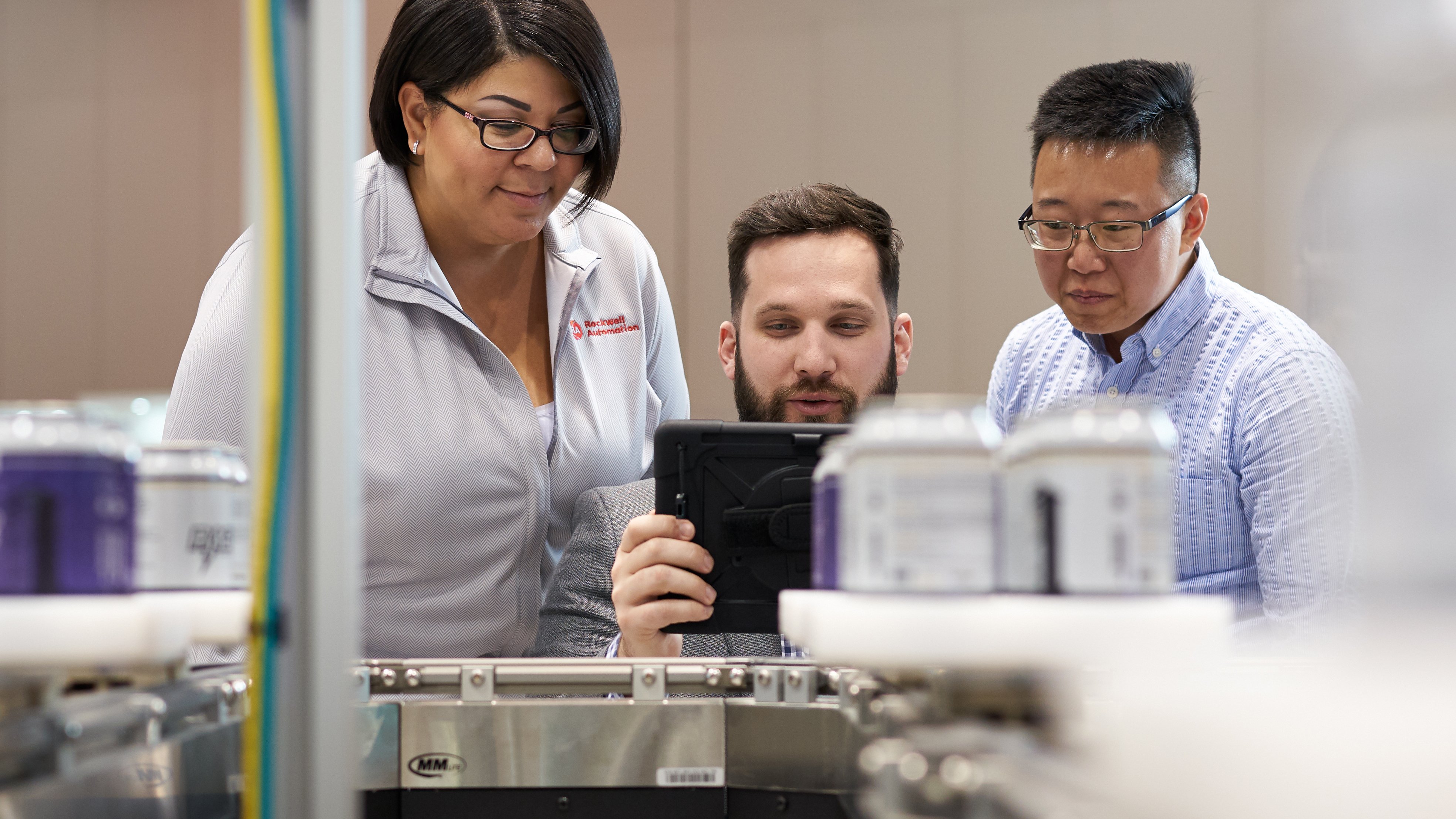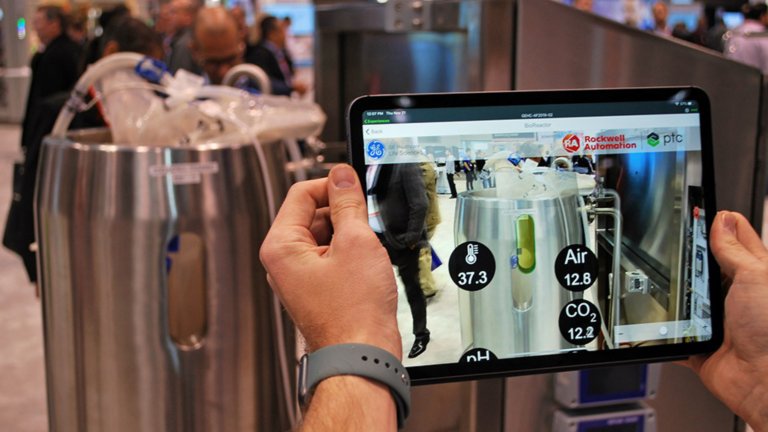Recommended For You
No business can afford to sit still. Least of all manufacturers. Only those who stay a step ahead stand a chance. Rockwell Automation has pushed beyond the initial stages of digital transformation to reach a state of continuous improvement—so they can remain on the forefront of whatever comes next.
We have always been at the forefront of innovation. How many manufacturers can say they’ve experienced more than a century of continued success? Rockwell Automation can. Established in 1903, what began as the world’s first motor control company has grown into a storied technology and manufacturing powerhouse. Through transformative events from the invention of the moving assembly line to the rise of industrial robotics, Rockwell Automation has always remained an industrial leader. Rockwell Automation has thrived for 117 years because they’ve stayed on the cutting edge for 117 years. Today, Rockwell Automation is building what’s next by applying that same mindset of innovation.
Rockwell Automation—both a global manufacturer and leading technology provider—is uniquely positioned to drive their own digital transformation. As a manufacturer, about one-third of their 23,000 employees work at 20 global manufacturing plants and manage a product catalog of nearly 400,000 SKUs.
And as the world’s largest company dedicated to industrial automation and digital transformation, they help companies around the world improve processes, reduce inefficiencies, and increase productivity.
Rockwell Automation is well into their own digital transformation
Given their heritage, the Rockwell Automation manufacturing arm embraced digital transformation before it became a buzzword. They started by combining multiple, disparate systems into one enterprise resource planning (ERP) system that could manage many others around the world. In parallel, they rolled out a manufacturing execution system (MES) as its centralized system of record—and spent the next several years going plant by plant to connect factories, processes, and people to a single MES.
These actions put Rockwell Automation at the forefront of OT/IT convergence—unifying IT and OT systems to provide new opportunities to access, monitor, and capitalize on operational, business, and transactional data across the manufacturing enterprise. This gave them the foundation to standardize workflows and processes across all facilities. Rockwell Automation established a globally standardized approach for connecting their factories around the world and set the stage for the next wave of digital transformation.
The results were significant. Rockwell Automation lowered their total cost of ownership, reducing inventory days from 120 to 82 and capturing 30% in annual capital avoidance. They have accelerated their time to market, with supply chain deliveries now up to 96% and lead times cut in half. Additionally, the company estimates it has experienced a 4 - 5% annual improvement in productivity.
The key to success is continuous improvement
As Rockwell Automation has demonstrated throughout their history, the ability to stay ahead of the curve requires a commitment to continuous improvement. Not only does it require solving for the needs of the present, but also anticipating those of the future. This means finding new ways to continually optimize operations and enable better decision making throughout the workforce—their greatest asset.
Although well into their own digital transformation and yielding significant improvements, Rockwell Automation was not content to rest on their laurels. With their factories connected and a single connected system across the globe, Rockwell Automation asked the hard question: what’s next?
Rockwell Automation wanted to ensure it was realizing the full benefits of their connectivity by driving standardization across operations. To do this, a team of connected enterprise specialists focused on key use cases designed to further optimize factory assets and empower their workforce with digital tools and resources.
Rockwell Automation accelerates transformation with FactoryTalk InnovationSuite, powered by PTC
Rockwell Automation employed FactoryTalk® InnovationSuite, powered by PTC, to build and advance to the next stage of their transformation. Across six global facilities, the suite infused edge-to-enterprise analytics, machine learning, internet of things (IoT), and augmented reality (AR) directly into their industrial operations. This powerful suite makes data more accessible, enables more informed business decisions, and facilitates long-term growth and continuous innovation. FactoryTalk InnovationSuite is the most comprehensive and effective way for manufacturers to optimize their people, products, and processes, and to accelerate their industrial transformation.
The technology on its own has enormous potential— but without specific use cases that can scale to multiple scenarios and facilities, the value can be limited and never hit the double-digit impact Rockwell Automation was looking for. To ensure a successful global rollout, Rockwell Automation identified use cases that would have the greatest benefit to their global operations and employees. By piloting the use cases in each location, they were able to facilitate a digital culture shift and help employees develop the right skillsets. At a high level, these use cases span from intelligent asset optimization to workforce productivity and enterprise operational intelligence.
Intelligent asset optimization
Too many manufacturers take a reactionary approach to managing production and performance issues. They depend on manual monitoring processes to assess machine health and utilization, or simply don’t have the ability to see critical information that could help them optimize operations. The resulting downtime and poor asset utilization are often costly and time consuming to fix. And as machines and operations become more complex, the impacts only become greater.
To overcome these challenges, the Operations team undertook strategic use cases with the goal of creating an intelligent approach to asset optimization. They leveraged real-time monitoring, diagnostics, and predictive and prescriptive analytics to gain valuable visibility and better understand the health and diagnostics of their machines. Equipped with these powerful monitoring tools, they were able to avoid unplanned downtime and maximize asset utilization. The team implemented three use cases in this area:
Throughputs
Rockwell Automation leveraged powerful real-time monitoring and analytics tools to both increase the quantity of output and decrease the labor cost per unit produced. With detailed data analysis of the production process—specifically around time between units and time per step—Rockwell Automation was able to optimize throughput for a new product in high demand. At one facility, double-digit results include a 33% increase in labor efficiency, a 70% increase in outputs, and a 50% reduction in training time.
Predictive maintenance
Rockwell Automation uses 35 injection molding machines of varying complexity and age, which made it difficult for them to efficiently determine machine status and prevent downtime. Leveraging IoT technology to collect vital, realtime information across legacy machines, they created a unified view of their factory floor, and achieved an 8% improvement in productivity. This enables them to enhance quality control, improve machine uptime, and ensure maintenance needs are met based on machine utilization.
Analytics
In order to reduce long production times on ball grid arrays, the team piloted a new machine learning test for good and bad ball grid connections. They created a 3D profile of the paste applied to boards, which would enable them to quickly determine whether there was a bad paste profile. As a result, they were able to detect issues earlier in assembly, reduce time to fix from hours to minutes, provide better quality assurance, and reduce paste related defects by 51%. Through each of these use cases, Rockwell Automation was able to optimize asset efficiency, reduce machine downtime, and increase throughput to satisfy customer demand. And this is just the beginning. “Now we have data sources connected and identified, and we can create new models to further improve our processes,” says Lion Moeliono, IT Manager, Global Plant Systems at Rockwell Automation.
At one facility, double-digit results include a 33% increase in labor efficiency, a 70% increase in outputs, and a 50% reduction in training time.
Digital workforce productivity
Like many manufacturers, Rockwell Automation understood that managing a digital workforce could be difficult. Without a clear view into machine performance, supervisors often struggled to separate worker issues from machine issues and ensure the best output. Furthermore, as skillsets like wiring rose in demand, the team had no systematic way to ensure employees were properly trained. In combination with high turnover, this posed significant risks to quality and safety. Solving these problems wasn’t just about improving the bottom line. The team sought to empower their workforce with digital tools—not only improving productivity but also creating an environment where employees feel valued for their accomplishments, day in and day out. They implemented four targeted use cases to better empower their workforce:
Work queue visibility
The lack of visibility into available work queues in highly automated and critical lines and assets often resulted in lines running out of material for processing—causing costly unscheduled line downtimes. By combining data from IT and OT sources and visualizing it together, Rockwell Automation realized a 75% reduction in line starved-condition downtime due to lack of materials, which enabled operators to optimize their work. Now we have data sources connected and identified, and we can create new models to further improve our processes.” Lion Moeliono IT Manager, Global Plant Systems at Rockwell Automation.
Standardized performance reporting
The team needed a clearer way to see the impact of downtimes on hourly performance, so they developed a common KPI dashboard for use across all plants. Combining disparate information from scheduling systems, SAP, MES, and other sources, the configurable and modular dashboard enabled workers to better visualize performance trends, make data-informed decisions and increase labor efficiency by 13%.
AR-guided wiring training & quiz
Ensuring employees could wire effectively had become an increasing challenge due to turnover. Additionally, there was no objective means to measure success, resulting in risks to quality and safety. Using AR technology to deliver a better training experience in an engaging way, Rockwell Automation was able to train employees and simultaneously measure competency to identify skill gaps.
AR-guided standardized work instruction product transfer
Relocating plants between Switzerland and Poland required teams to transfer critical and detailed knowledge across countries and languages. The team in Switzerland began recording work instructions using AR technology, breaking down tasks into step-by-step instructions with pictures, video, and voiceover and reduced training time by 30%. In just one day, the operations team in Switzerland built a library of 80 videos and was able to deliver training to the Polish team before the plant was even up and running. Rockwell Automation provided workers with actionable, augmented information they can use to improve productivity, safety, and employee satisfaction—not just on one line, but across the enterprise. “We’re trying to get to where they work with the issue for about five minutes and if they can’t resolve it in that time, they escalate to support groups. If they’re having trouble, we want them to reach out to support so they can more quickly resolve the issue,” says Moeliono. Through each use case, Rockwell Automation was able to help connect people with technology to deliver the best results for their employees and customers.
Enterprise operational intelligence
The above use cases are only the beginning, as they continue to look for new innovations and ways to infuse intelligence into their operations. Now, they aim to create enterprise-wide operational intelligence to improve performance across all factories—through continuous bottleneck identification, actionable KPIs, loss prioritization, and tracking the value deliverable. For example, because they had standardized workflows and unified OT and IT systems, Rockwell Automation had a blueprint for a connected supply chain—allowing them to track and trace quality issues. These benefits will increase exponentially as they add more data and use cases.
Ensuring traceability in the supply chain
When Rockwell Automation experienced a jump in demand for component parts for electronic assembly and had to procure material from an external source, they quickly discovered that non-conforming parts had been introduced into their supply chain. Leveraging the intelligence from FactoryTalk MES, unified IT and OT systems, and standardized processes, they were able to identify the issue and trace it throughout their supply chain to prevent any more problems in the future. This capability can reduce recalls by 80% or more, in any given situation.
The quality issue is just one example of how a seemingly narrow use case can scale to global application by leveraging a flexible and intelligent solution. “We could pivot and avoid problems while not disrupting current production. It made the whole effort so much easier,” says Brian McCaffrey, Production MES Operations Manager at Rockwell Automation. “In our business, it saved us a lot of extra effort.”
Rockwell Automation reduced recalls by 80% or more.
Next steps
As Rockwell Automation continues to optimize operations and increase workforce opportunities, it will rely on its connected systems and flexible technology to accommodate new innovations. As a proven leader in manufacturing, Rockwell Automation is living proof of the business imperative to transform, with evidence across their operations of how technology can support improvements in large and small ways, inspiring people to deliver their best work every day.
Looking forward, Rockwell Automation is building off these recent learnings. They’re challenging themselves on how they can drive further improvements for workers, equipment, and processes, with the goal of creating even more customer and employee value.
They’re arming employees with better training by leveraging breakthrough AR technology and providing opportunities for higher-level responsibility as more manual tasks become automated. They’re protecting their assets by turning tons of data into improved prediction and prescription capabilities, to manage machine performance and maintenance at a new level of precision.
Every day, they’re learning more about the capabilities of their own technology, only limited by their imaginations and the time it takes to continuously improve and transform, one step at a time.
Published January 28, 2021





